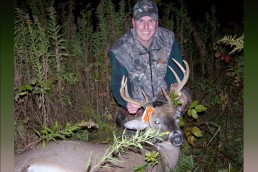Fencerow Strategies for Whitetails
SHARE THIS POST
Darin Potter explains how key spots along fencerows funnel deer through and provide prime shooting opportunities.
During the late-summer months, I spent many evenings glassing deer from my truck and also my friend’s golf cart, which allowed us to drive quietly along a trail to the edge of a large field where deer like to feed. This time of year, bucks are still in their bachelor groups tolerating each other’s company, and occasionally we would observe these deer together in full velvet. On one particular evening, we spotted a couple of nice bucks, which both sported eight points. We glassed them from nearly a mile away and watched as they walked along a fence line, heading north to a small field of corn. Fortunately, I had permission to hunt this piece of property and didn’t have to think very long as to where I was going to place a treestand.
A large gap along the fencerow was just the ticket. Here, I found a well-used trail that ran perpendicular to the fencerow, along with a large field of soybeans on both sides. To the north was a small pond, with a large patch of goldenrods to the south. With a stand surrounded by food, water and cover, this place was a deer magnet, and I couldn’t wait to hunt it come October.
Deer feel comfortable in this type of fencerow because it is old and full of large trees and underbrush. In the open farm country of the thumb area in Michigan where I use to bowhunt for deer, the fencerows are oftentimes the only available cover that deer have in the entire area.
Deer choose fencerows for several different reasons. Wind tends to blow straight across the surrounding fields, consistently allowing deer to scent-check for predators from the security of the thick cover that old fencerows provide. They also have an unobstructed view of any potential threats that may appear in these fields. The many miles of laid-out fence line that farmers have created provide deer with safe travel routes to food, cover and water. Deer trails can be found running parallel and perpendicular at several different points along these fence lines.
You’ve probably noticed old fences where fence posts have deteriorated, causing sections of the fence to droop, or whose wire has corroded, creating small openings in the fence. These are the preferred crossing points for deer—especially where a low point exists in the terrain. They always tend to take the path of least resistance. Setting up a treestand in these locations can increase your chances of harvesting a mature buck.
Numerous buck rubs and scrapes can also be found scattered along fence rows. Find a low, overhanging branch about four to five feet tall that sticks out into a field, and chances are an active scrape can be found underneath it. Scan the smaller saplings that exist within these fence lines for rubs. Even if the rubs were made in past years, this could still be a promising spot to set up a stand. The same buck that made them last year could reappear the following year, offering you a shot.
Are you enjoying this post?
You can be among the first to get the latest info on where to go, what to use and how to use it!
Fencerow hunting strategies
Because there is such a narrow section of cover within fencerows, it is essential to choose a tree that provides you with as much cover as possible. A large tree with a diameter larger than your body will prevent skylight from giving your position away. It is also important to leave as much cover on the tree as possible. The tree that I placed a stand in last fall along a fence row had a vine that stretched out about 20 feet high and provided excellent cover for me during the first month of the season.
If the canopy is thin, it may be necessary to tie a few dead branches to the top part of your stand, rails or other live branches to provide more cover for you. Some fencerows have lots of deer sign, but very few trees to place a stand. In this situation, a ground blind may be necessary. Position the ground blind so that it is downwind of a food source or runway, and then brush in your blind with surrounding cover so that you will remain undetected.
Scent control strategies are an absolute must when hunting along a fence row. When approaching your stand for a morning or evening hunt, walk into the wind and try not to use the same path for consecutive days. Keep these stands fresh by alternating your approach and take your time walking in as quietly as possible.
Wear rubber boots and, if donning a scent-controlling suit, make sure to put your pant legs over top of the boots so the carbon will absorb the puff of air that is created when you walk.
Hunting fencerows for bucks is certainly a place that, with proper scouting and paying attention to details, can be extremely rewarding. You just might end up filling your tag early in the archery season.
Read about more interesting fishing and hunting destinations in every issue of MidWest Outdoors. Subscribe on our website.
MWO
SHARE THIS POST
You may also like...
Nothing found.
Did you enjoy this post?
You can be among the first to get the latest info on where to go, what to use and how to use it!
Darin Potter
Darin Potter’s passion for outdoor writing began at the age of 12 when he first began writing in a journal that his parents bought him on a family camping trip in Northern Michigan. His writings have appeared in several Midwest publications: Michigan-Out-of-Doors, Michigan and Ohio Outdoor News, Modern Pioneer, and MidWest Outdoors.
